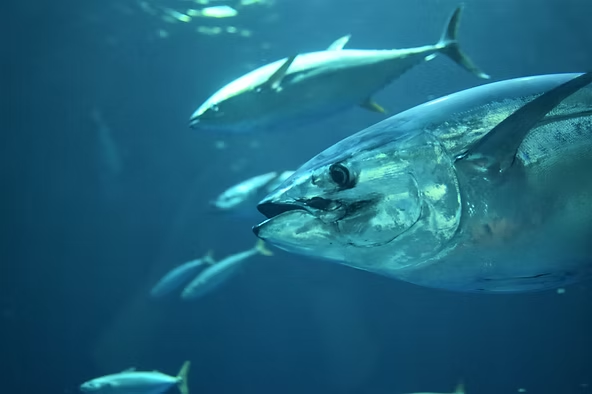Atlantic Bluefin Tuna: Ocean’s Giant Predator
The Atlantic bluefin tuna is among the fastest and strongest predators in the open ocean. It is also the largest member of the mackerel family, historically reaching up to 2000 pounds (900 kg) and nearly 15 feet (4.6 m) in length. These giants prefer to feed on pelagic fishes and invertebrates, swallowing their prey whole.
Life Cycle and Growth
Like many bony fishes of the open ocean, Atlantic bluefin tuna begin life as tiny larvae only a few millimeters long and weighing fractions of a gram. Within just three to five years, they reach about three feet (1 m) and become sexually mature. Their growth from microscopic larvae to massive predators requires a varied diet: young tunas eat zooplankton, while adults consume larger fishes and invertebrates. Throughout their lives, they are preyed upon by different animals—small fishes when young, and only the largest billfishes, toothed whales, and sharks when fully grown.
Migratory Patterns and Reproduction
Atlantic bluefin tuna are highly migratory, traveling vast distances each year to feed and spawn. They reproduce through broadcast spawning, where males and females release millions of eggs and sperm into the water column simultaneously. This strategy increases fertilization success while reducing egg predation. Two main populations are recognized: one spawning in the Gulf of Mexico and another in the Mediterranean Sea. Some scientists believe the Mediterranean stock may actually consist of two distinct groups, a factor with significant implications for fisheries management.
Unique Adaptations
Although most fishes are cold-blooded, Atlantic bluefin tuna have a specialized blood vessel system called a countercurrent exchanger. This adaptation allows them to maintain body temperatures above surrounding waters, giving them an advantage when hunting in cold environments. Combined with their streamlined shape, this makes them among the fastest swimmers in the ocean. Like certain sharks, they must swim continuously to breathe, passing water over their gills to oxygenate their blood.
Fisheries and Conservation Concerns
The Atlantic bluefin tuna is one of the most valuable commercial fish species, particularly in the high-end sushi markets of Japan and beyond. Its immense value has driven intense fishing pressure, contributing to population declines. Once abundant in the Black Sea and off Brazil, the species has virtually disappeared from these regions, experiencing one of the largest range contractions of any open ocean fish. Today, scientists classify the species as endangered, though commercial fishing still occurs. While recent strict regulations show signs of population recovery, sustained conservation and management are essential to secure its future.
Closely Related Species
For decades, all bluefin tunas in the Northern Hemisphere were thought to be the same species. While Southern bluefin tuna (Thunnus maccoyii) has long been recognized as distinct, only recently have researchers separated Atlantic bluefin (Thunnus thynnus) and Pacific bluefin tuna (Thunnus orientalis) into different species. This distinction is important for both conservation and fisheries management worldwide.

